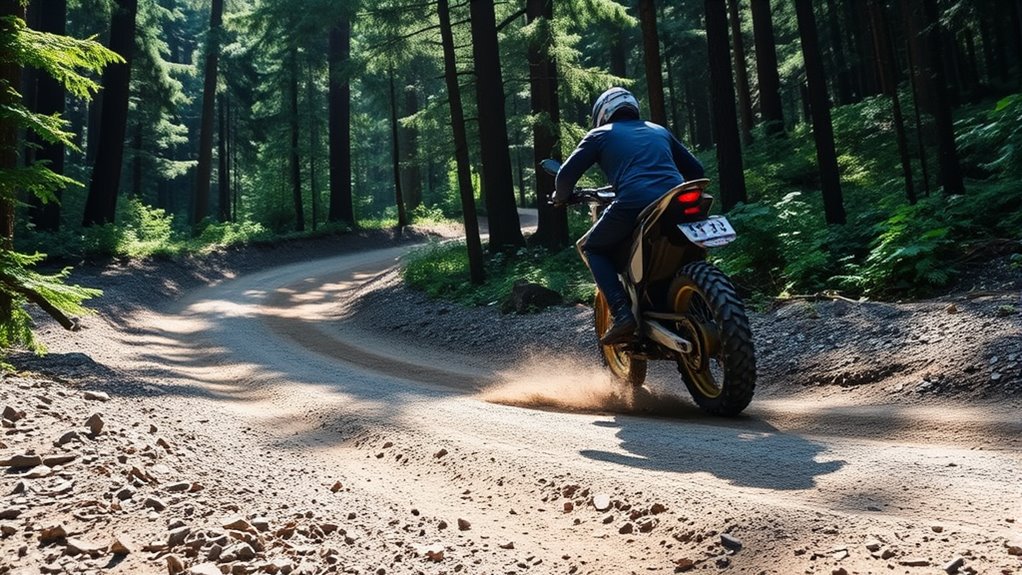Trail braking off-road helps you control your bike through turns on tricky surfaces like loose gravel, mud, and rocks. Use gentle, smooth brake pressure as you approach a turn, gradually reducing it while leaning into the corner. Keep your body centered and eyes ahead for stability. Avoid abrupt braking or locking the wheel. Mastering these techniques lets you handle various terrains confidently—continue exploring to learn how to refine your trail braking skills further.
Key Takeaways
- Use trail braking approaching technical sections, sharp turns, or uneven terrain for better control.
- Apply gradual, steady brake pressure while entering and during turns to avoid wheel lockup.
- Keep body centered and eyes ahead, adjusting brake pressure smoothly to maintain stability.
- Reduce braking early on loose or muddy surfaces, increasing control and grip.
- Practice in controlled environments to build confidence and refine off-road trail braking skills.
Understanding the Principles of Off-Road Trail Braking
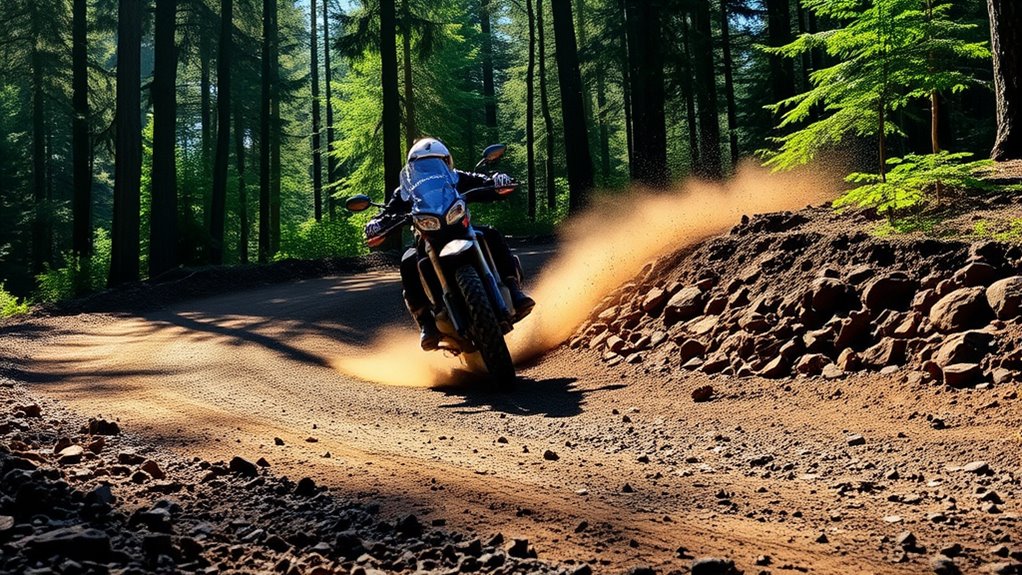
Off-road trail braking involves intentionally applying the brakes while entering and maneuvering a turn to control speed and improve stability. By doing this, you transfer weight forward, increasing tire grip on loose or uneven surfaces. This technique helps you maintain better control through tricky sections, especially on unpredictable terrain. The key principle is modulating brake pressure smoothly to avoid locking wheels or losing traction. As you brake into a turn, your goal is to reduce speed gradually, allowing the bike to settle and stay balanced. Proper understanding of trail braking’s principles enables you to adjust your braking force dynamically, adapting to changing terrain conditions. Developing a good sense of vehicle control is essential for mastering this technique, as it allows you to respond effectively to different trail challenges. Mastering this control technique makes your off-road riding safer, more efficient, and more confident.
Recognizing When to Employ Trail Braking on Trails
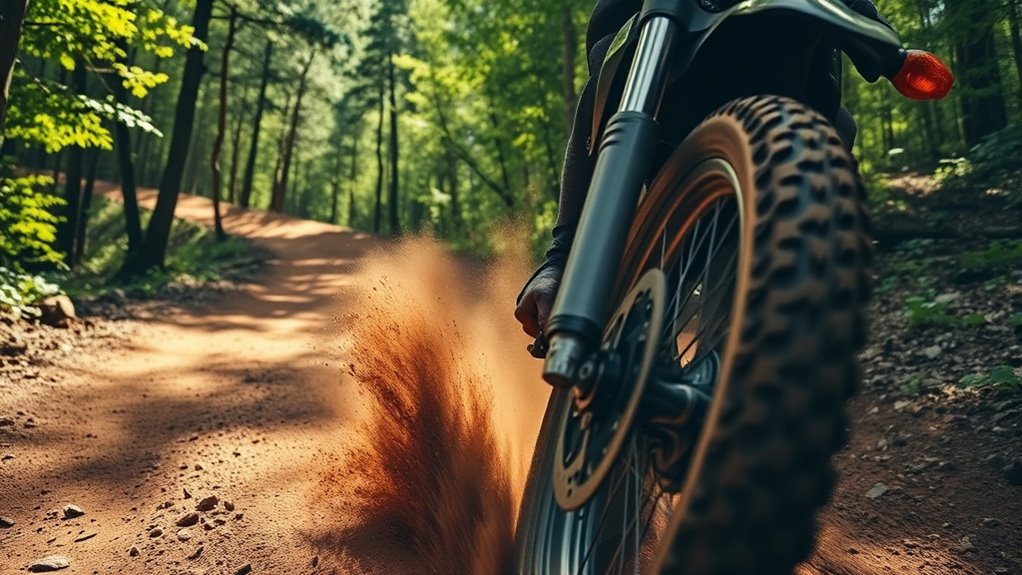
Knowing when to employ trail braking on trails is crucial for maintaining control and adapting to changing terrain. You should consider trail braking when approaching technical sections, sharp turns, or uneven surfaces where deceleration helps you maintain stability. If you notice your bike starting to drift or lose traction, it’s a sign you might need to apply light braking while entering the turn. Additionally, when trail conditions are loose, muddy, or rocky, trail braking can help you modulate speed smoothly without losing grip. Pay attention to your bike’s response—if it feels unstable or you’re losing control, easing off the brake can restore balance. Mindfulness of emotional balance and stability can also enhance your riding focus and decision-making. Recognizing these cues ensures you use trail braking effectively to navigate tricky sections safely and confidently.
Proper Technique for Executing Off-Road Trail Braking
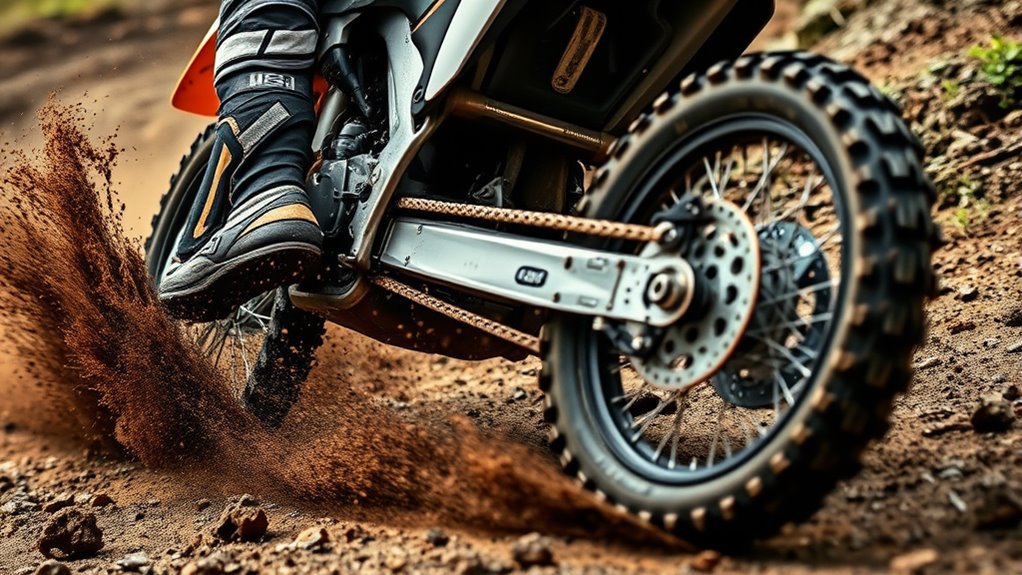
To execute proper trail braking off-road, you need to develop a smooth and controlled application of the brake while entering and maneuvering turns. Focus on gradual pressure, avoiding sudden releases or heavy braking, which can unsettle your bike. As you approach the turn, gently squeeze the brake lever, maintaining a steady, consistent force. Keep your body centered and eyes looking ahead. To better understand the technique, consider this table:
| Stage | Brake Application | Body Position |
|---|---|---|
| Approaching turn | Light, progressive squeeze | Slightly forward |
| Entering turn | Maintain steady pressure | Centered, relaxed |
| Mid-turn | Reduce brake pressure | Shift weight slightly |
| Exiting turn | Release brake smoothly | Prepare for acceleration |
| On straight | Release brake completely | Upright, balanced |
Mastering this flow guarantees control and stability off-road.
Common Mistakes to Avoid When Trail Braking Off-Road
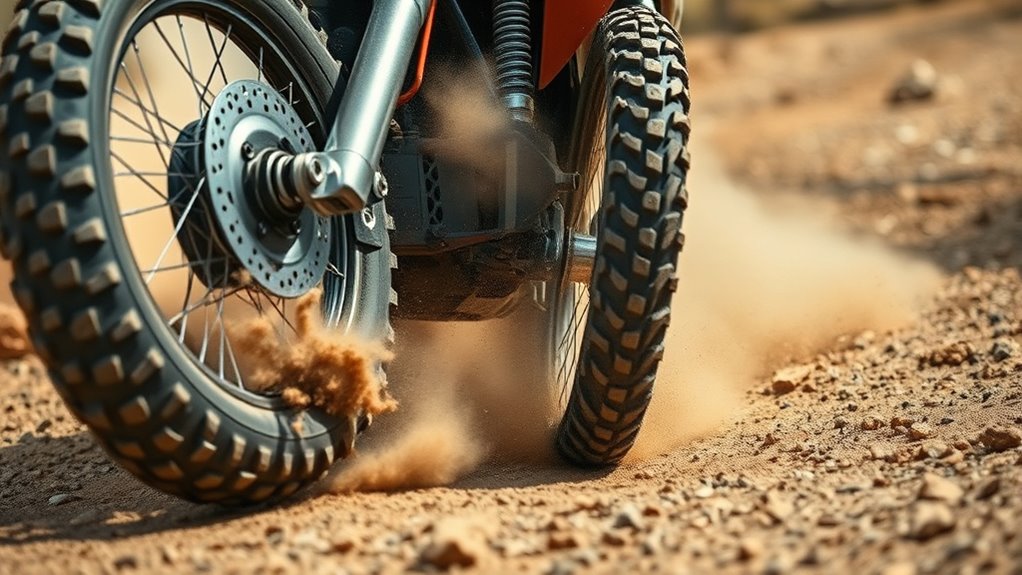
One common mistake is applying too much brake pressure too quickly, which can unsettle your bike and cause loss of control. Instead, focus on gradual, controlled braking to maintain stability. Locking the wheel is another error; it reduces traction and increases the risk of a crash. Always modulate your brake force smoothly, especially on loose or uneven terrain. Over-braking can also shift your weight backward, making steering more difficult and compromising balance. Additionally, avoid braking while turning sharply, as this can lead to skidding or washouts. Keep your eyes ahead and anticipate terrain changes to brake early and progressively. Proper color accuracy in your braking technique can help you better judge your speed and stopping distance in off-road conditions. By avoiding these mistakes, you’ll maintain better control, improve your riding confidence, and handle off-road trails more safely.
Adapting Trail Braking to Different Terrain Conditions
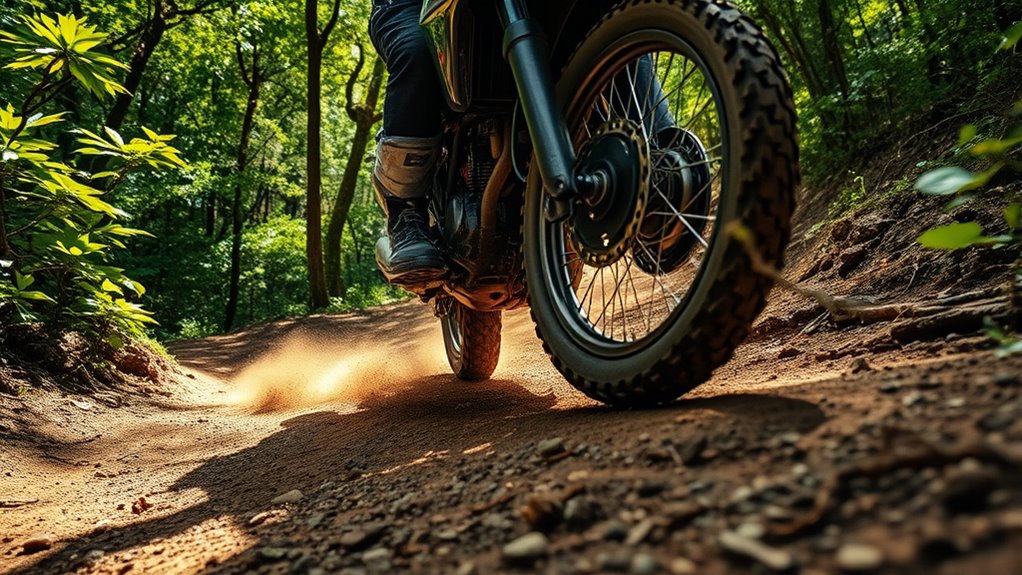
Adjusting your trail braking technique to suit different terrain conditions can markedly enhance your control and safety. On loose surfaces like gravel or sand, reduce your braking pressure early and ease into it gradually, allowing the bike to maintain traction. When riding on muddy or wet trails, keep your braking gentle and progress smoothly to avoid losing grip. For harder pack or rocky terrain, you can apply a bit more braking force but stay alert for sudden changes in traction. Uphill sections may require less braking overall, focusing instead on maintaining momentum, while downhill sections might demand more controlled braking to prevent sliding. Always observe how your bike responds and adapt your pressure accordingly to stay balanced and in control.
Tips for Building Confidence and Mastering Trail Braking
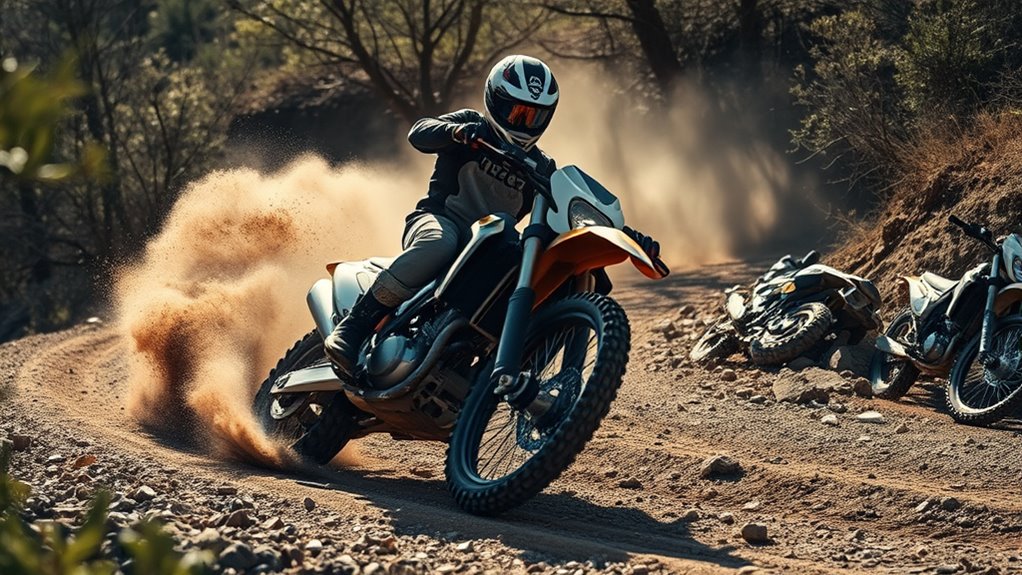
Building confidence in trail braking starts with practicing in controlled environments where you can focus on feel and technique without the pressure of challenging terrain. Begin on smooth, flat surfaces to get a sense of how your bike responds when you apply the brake while leaning into a turn. Keep your inputs gradual and deliberate, avoiding sudden or aggressive movements. As you gain comfort, gradually introduce gentle off-road features like loose gravel or small rocks to adapt your technique. Remember to stay relaxed, maintain a steady throttle, and look ahead. Kia Tuning can include suspension upgrades that enhance your bike’s handling during trail braking. Consistent practice helps you develop a feel for the bike’s behavior, building trust in your ability to control it. With patience and repetition, trail braking becomes a natural and confident part of your riding skills.
Frequently Asked Questions
How Does Trail Braking Differ Between Dirt and Rocky Terrains?
You might wonder how trail braking varies between dirt and rocky terrains. On dirt, you can brake later and more aggressively because the surface offers more grip, helping you maintain control. In rocky conditions, you need to brake gently and early, focusing on precision to avoid slipping or damaging your tires. Adjust your braking pressure and timing based on terrain to stay safe and maintain stability.
What Are Signs Indicating It’s Unsafe to Continue Trail Braking?
Think of trail braking as riding a delicate dance on the edge of control. If your bike starts wobbling like a leaf in the wind, or if your steering feels heavy and unresponsive, it’s a red flag. When traction slips away like sand through your fingers or the bike veers unexpectedly, it’s time to ease off. Safety’s your best partner—know when to stop before the dance turns into a tumble.
Can Trail Braking Improve Overall Off-Road Bike Control?
Trail braking can definitely enhance your off-road bike control. By gradually reducing speed while entering turns, you maintain better traction and stability, especially on loose or uneven terrain. It helps you gauge grip levels and adapt your riding. You stay more connected to the trail, allowing smoother progressions and quicker responses. When done correctly, trail braking boosts your confidence, precision, and overall control, making off-road riding safer and more enjoyable.
How Do Weather Conditions Affect Trail Braking Techniques?
You might think weather doesn’t impact trail braking, but it actually plays a big role. Wet, muddy, or icy conditions reduce traction, making it riskier to brake hard while turning. You should ease off the brakes earlier and apply gentle, controlled pressure to avoid slipping. Adjust your technique based on the weather, and always stay alert to changing conditions to maintain control and safety on off-road trails.
Is Trail Braking Suitable for Beginner Off-Road Riders?
Trail braking can be suitable for beginners if approached carefully. It helps you control speed and navigate tricky terrain, but it requires smooth, gradual application of the brake. Start practicing on gentle slopes and low speeds, focusing on maintaining balance and control. As you gain confidence, you can incorporate trail braking into your riding. Always prioritize safety, and don’t push beyond your comfort zone while learning this technique.
Conclusion
Mastering off-road trail braking is like tuning a finely crafted instrument—you’ll feel when to press and when to ease off as your skills improve. With practice, you’ll navigate rough terrains smoothly, turning challenging trails into your personal dance floor. Embrace the learning process, trust your instincts, and soon trail braking will become second nature. Remember, every trail is a new song waiting to be played—so enjoy the rhythm and ride with confidence.
